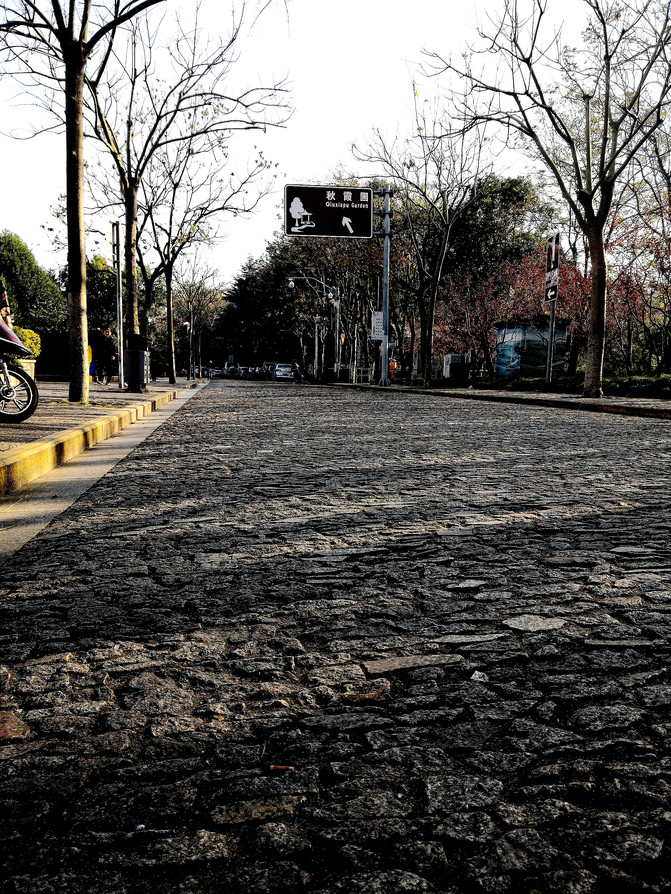Autumn scenery in Jiading Autumn Sunset Garden Guyi Garden
The early winter of December 2019 was as warm as autumn, and Shanghai was still an autumn scene. I invited my photographers and colleagues to go on an outing to seize the last touch of autumn. Two classical gardens, Qiuxiapu and Nanxiang Guyi Garden, in Jiading District, were selected as shooting spots.
On December 9, on a sunny day, take Metro Line 11 to Jiading North at 8 a.m., change to the Jiading No. 12 bus to get off at Bole Square, retreat to East Street, walk about 150 meters along Shanghai's almost extinct Tangge Road, enter Qiuxiapu Park at 9 o'clock.

Qiuxiapu
Located in the Urban area of Jiading, it is a Shanghai classical garden that is as famous as Yu Garden, Guyi Garden, Zuibaichi and Qushui Garden. Qiuxia Garden has a compact layout, with a clear water pond as the center, surrounded by rocky mountains and towering ancient trees. Walking in the garden gives you a unique feeling of "one step at a time".
Qiuxiapu is formed by the merger of three private gardens: Gong's Garden, Shen's Garden, Jin's Garden and Yi Temple (i.e. City God Temple). Most of the buildings in the park were built in the Ming Dynasty, while Yi Temple dates back to the Song Dynasty. Qiuxia Garden is divided into four scenic spots: Taohuatan Scenic Area, Ningxia Pavilion Scenic Area, Qingjingtang Scenic Area and Yimiao Scenic Area. The main part is the Chishang Cottage of Taohuatan Scenic Area. Every autumn, the red maples inside dye the garden, making it very suitable for viewing the maples and taking photos.









From the south gate of Qiuxiapu, we first enter the Yimiao Scenic Area in the southeast of the garden. The main buildings are the main hall, I-shaped corridor, and bedroom, all of which are relics of reconstruction during the Guangxu period of the Qing Dynasty. The main hall is grand and tall. It is now the "Shanghai Customs and Customs Photo" showroom of the Shanghai Folk Culture Expo Center. There are large beds and other furniture in the bedroom, which are beautifully decorated. In addition, the well pavilions on both sides of the south gate of the garden are the original objects of the Yi Temple.







Ningxia Pavilion Scenic Area is located in the east of the garden. It was originally the former site of Shen's Garden. The courtyard corridors in the garden are connected and a large number of trees, flowers and plants are planted. It is centered on Daping Mountain built by Taihu Lake stones, and surrounded by buildings such as Ningxia Pavilion, Liaoyan Hall, Youcheng Hall, Fushutang, Huancuixuan, Pingshan Hall, Shuyuzhai and other buildings.
Taohuatan Scenic Area is in the southwest of the garden and is the original part of Gong's Garden. Here is Taohuatan as the center. In the south, there are Wanxiangju, Jixia Pavilion, Chishang Cottage, and Yi Comfort Hall. In the west, there are Cong Guixuan. In the north, there are Jishan Pavilion, Biguang Pavilion and other buildings. They are either built on the mountain or built on the edge of the pool. Chishang Cottage looks like a boat bowing, so it is also known as a boat rather than traveling in a pavilion. You can enjoy the beautiful color of the Peach Blossom Pond here.
Qingjingtang Scenic Area is in the north of the garden and is the site of Jinshi Garden. In the south, there is Qingjing Pond connected to Taohuatan, in the north, there are Sanyintang, in the east are Liuyunju, Qiushuixuan and Qingxuan, and in the west are Qingsong Ridge, Suihan Pavilion and Buting Pavilion. Qingsong Ridge is a small hill made of soil. It is planted with pine trees, red maples, white magnolia, wintersweet and other trees. It is also equipped with rockery waterfalls and pavilions. It is a good place to take a cool rest.





























































































At noon, take the Shanghai-Tang special bus to Guyi Garden. After tasting Shanghai's famous Nanxiang Xiaolong and Yuyuan Soup at Guyi Garden Restaurant, they took a break and entered the park. Hold it until the sun sets west and begins to return home.
Ancient Yuan was built during the Jiajing Period of the Ming Dynasty (1522-1566 AD). It is a private house, formerly known as "Yi Yuan", which is taken from the sentence "Yi Yi of Green Bamboo" in the Book of Songs. In the 11th year of Qianlong of the Qing Dynasty (1746), the park was renamed "Guyu Garden". The architectural style of the ancient garden is the same as that of Suzhou gardens. The pavilions and pavilions between small bridges and flowing water change the scenery, simple and elegant.
There are two gates in Guyu Garden. Entering at the south gate is Nanxiang Wall (Zhaobi), entering at the north gate is Yiyetang, entering at the south gate and exiting at the north gate, or entering at the north gate and exiting at the south gate. There is no need to turn back. If you have time, you can go to Nanxiang Ancient Town for a stroll. Among them, Yiye Hall is the main hall in the garden. It has nanmu as pillars and is connected by roads on all sides. Standing in the hall, you can see the scenery around you. To the east of Yiye Hall is the Goose Playing Pond, and to the south of the Goose Pond is a more peculiar building in the Ancient Garden-the Corner Pavilion. Among the four corners of the pavilion, the northeast corner is missing. Go east, pass Yuanyang Lake, Songhe Garden, and reach Qingqing Garden. Here you can see the real scenery of "green bamboo". The ancient buildings with flying eaves and crooked corners under the bamboo forest look fresh and elegant.














































































































